 W
WThe Abd al-Kuri sparrow is a passerine bird endemic to the small island of Abd al Kuri in the Socotra archipelago of the Indian Ocean, off the Horn of Africa. Though this species was originally described as a distinct species, it was considered conspecific with the Socotra sparrow. A study by Guy Kirwan showed significant differences from the Socotra sparrow, and that the two sparrows might even have different origins. On the evidence that it is morphologically distinct, BirdLife International recognised it as a species, and it was listed in the IOC World Bird List from December 2009. It has a very restricted distribution, and a population of under 1,000 individuals, so despite not having any known threats it is considered a Vulnerable species on the IUCN Red List.
 W
WThe Arabian golden-winged grosbeak or Arabian grosbeak is a finch found in Saudi Arabia, Oman and Yemen. It is included as a subspecies in R. socotranus by some authorities, but in recent times the three golden-winged grosbeak populations are usually considered distinct species.
 W
WThe blue-whiskered tanager is a species of bird in the family Thraupidae. It is found in the Chocó of Colombia and Ecuador. Its natural habitat is subtropical or tropical moist lowland forests. It is threatened by habitat loss.
 W
WThe brown oriole is a species of bird in the family Oriolidae.
 W
WThe buff-throated warbler is a species of leaf warbler. It was formerly included in the "Old World warbler" assemblage.
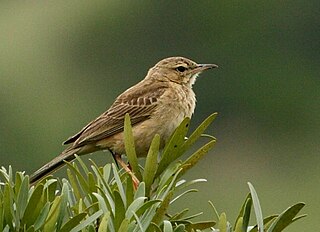 W
WThe buffy pipit is a species of bird in the Motacillidae family. It is found in plains and open countryside in southern and eastern Africa. The IUCN has assessed its conservation status as being of least concern.
 W
WThe Buru racket-tail, is a species of parrot in the family Psittaculidae. It is endemic to forest on the island of Buru, one of the Maluku Islands of Indonesia.
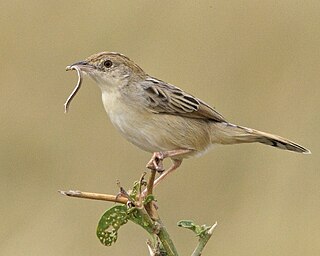 W
WThe desert cisticola is a species of bird in the family Cisticolidae. It is present throughout much of Sub-Saharan Africa, although relatively absent from central and coastal western areas of the continent.
 W
WThe grey-breasted parakeet is a species of parrot in the family Psittacidae. It is endemic to Ceará in north-eastern Brazil and restricted to a few mountains with relatively humid forest and woodland in a region otherwise dominated by arid Caatinga. They now only live in two locations, Serra do Baturité and Quixadá.
 W
WThe grey-chested babbler, also known as the grey-chested kakamega or grey-chested illadopsis, is a species of bird in the family Modulatricidae. It is the only species in its genus.
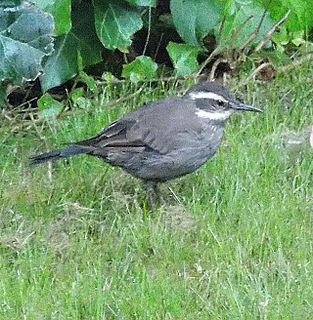 W
WThe grey-flanked cinclodes is a species of bird in the family Furnariidae. It is found in Chile, adjacent western Argentina and Tierra del Fuego. Its natural habitats are subtropical or tropical dry shrubland and subtropical or tropical high-altitude shrubland.
 W
WThe Hainan blue flycatcher is a bird in the family Muscicapidae. The species was first described by William Robert Ogilvie-Grant in 1900. It is found in Cambodia, China, Hong Kong, Laos, Myanmar, Thailand, and Vietnam. Its natural habitat is subtropical or tropical moist lowland forests.
 W
WHinde's babbler, also known as Hinde's pied-babbler, is a species of bird in the family Leiothrichidae. It is endemic to Kenya. Its natural habitats are subtropical or tropical moist shrubland, arable land, and plantations. It is threatened by habitat loss.
 W
WKakamega greenbul, is a species of the bulbul family of passerine birds. It is found in east-central Africa. Its natural habitats are subtropical or tropical dry forests and subtropical or tropical moist montane forests.
 W
WThe Malindi pipit is a species of bird in the family Motacillidae. It is found in Kenya and Somalia. Its natural habitats are subtropical or tropical dry lowland grassland and subtropical or tropical seasonally wet or flooded lowland grassland. It is threatened by habitat loss.
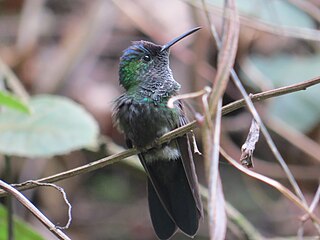 W
WThe Mexican woodnymph is a species of hummingbird in the family Trochilidae endemic to western Mexico. It lives in subtropical or tropical moist lowland/foothill forest and plantations, feeding on flower nectar and insects. Mexican woodnymphs are vulnerable, threatened by habitat loss through deforestation.
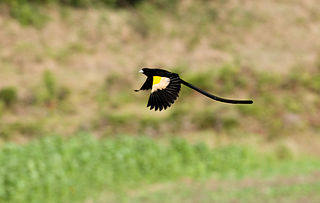 W
WThe montane widowbird, also known as the mountain marsh widowbird is a species of bird in the family Ploceidae, which is native to the eastern Afrotropics.
 W
WThe Negros bleeding-heart pigeon is endemic to the Philippines where it is found on the islands of Negros and Panay. It is critically endangered; continuing rates of forest loss on the two islands where it occurs suggest that it will continue to decline. The species has an extremely small, severely fragmented population. The bird is listed as an EDGE species under the analysis of the Zoological Society of London.
 W
WNewell's shearwater or Hawaiian shearwater (ʻaʻo), is a seabird in the family Procellariidae. It belongs to a confusing group of shearwaters which are difficult to identify and whose classification is controversial. It was formerly treated as a subspecies of the Manx shearwater and is now often placed in Townsend's shearwater. It is endemic to the Hawaiian Islands.
 W
WThe pale-headed brushfinch is a species of bird in the family Passerellidae. It is endemic to arid areas with low scrub at altitudes of 1,650–1,800 m (5,410–5,910 ft) in south-central Ecuador.
 W
WThe Papuan parrotfinch is a common species of estrildid finch found in New Guinea. It has an estimated global extent of occurrence of 50,000 to 100,000 km2. There is some doubt as to whether this species and the blue-faced parrotfinch are conspecific.
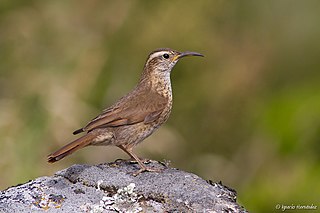 W
WThe Patagonian forest earthcreeper, also known as the forest earthcreeper, is a species of bird in the ovenbird family Furnariidae. The species was described in 1900 by W.E.D. Scott, but was listed as a subspecies of the scale-throated earthcreeper in Chapman in 1919. A 2009 paper elevated it back up to species status.
 W
WThe Pitcairn reed warbler is a songbird in the genus Acrocephalus. Formerly placed in the "Old World warbler" assemblage (Sylviidae), it is now in the newly recognized marsh-warbler family Acrocephalidae.
 W
WThe pygmy eagle or New Guinea hawk-eagle is a bird of prey found in New Guinea. Its natural habitats are primarily subtropical or tropical moist lowland forest and subtropical or tropical moist montane forest. It was the smallest species of eagle.
 W
WThe rufous-headed parrotbill, or greater rufous-headed parrotbill, is a parrotbill in the family Sylviidae and is found in eastern Asia from the eastern Himalayas to Indochina.
 W
WThe Samoan triller, known in Samoan as miti tae, is a species of bird in the family Campephagidae. It is endemic to Samoa. Its natural habitats are subtropical or tropical moist lowland forest and plantations. It is threatened by habitat loss.
 W
WThe Santa Marta antpitta is a species of bird in the family Grallariidae. It is endemic to Colombia. Its natural habitat is subtropical or tropical moist montane forest. It is threatened by habitat loss.
 W
WThe São Tomé spinetail is a species of swift in the family Apodidae. It is endemic to São Tomé and Príncipe. The species was described by Ernst Hartert on 1900.
 W
WThe scarlet-breasted dacnis is a species of bird in the family Thraupidae. It is found in Colombia and Ecuador. Its natural habitat is subtropical or tropical moist lowland forests. It is threatened by habitat loss.
 W
WThe scarlet-faced liocichla is a bird in the family Leiothrichidae. The species was recently reclassified as separate from the red-faced liocichla, although some taxonomists consider it to be conspecific. It is found in Myanmar, Thailand, Vietnam, and southern China.
 W
WThe spinifexbird is endemic to inland Australia. Also known as Carter's desertbird, it is named after Thomas Carter, an English ornithologist and pastoralist active in Western Australia from 1887 to 1928.
 W
WThe Tres Marías amazon is a parrot in the family Psittacidae. Many authorities consider it a subspecies of the yellow-headed amazon, including the AOU, but is afforded full species status by the International Ornithological Congress It is endemic to the Islas Marías off the Pacific coast of Mexico.
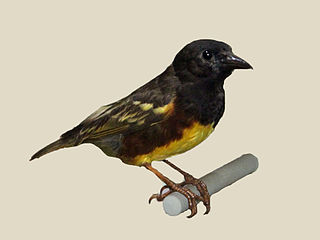 W
WWeyns's weaver is a species of bird in the family Ploceidae. It is found in Uganda and adjacent eastern Democratic Republic of the Congo and north-western Tanzania.
 W
WThe white-chested alethe is a species of bird in the family Muscicapidae. It is found in Malawi, Mozambique, Tanzania, and Zambia.
 W
WThe white-headed bulbul is a songbird species in the bulbul family, Pycnonotidae.
 W
WThe white-shouldered black tit, also known as the pale-eyed black tit, is a passerine bird in the tit family. It breeds in a belt across Africa from Senegal in the west to Kenya and Ethiopia in the east. It is sometimes considered conspecific with the more southerly white-winged black tit Melaniparus leucomelas and, like that species, it is mainly black with a white wing patch, but differs in that it has a pale eye.
 W
WWoodward's batis, also known as Woodwards' batis or the Zululand batis, is a species of small bird in the wattle-eyes family, Platysteiridae. It occurs in southeastern Africa where it is found in woodlands and forests.
 W
WYunnan fulvetta is a species of bird in the family Alcippeidae. It is endemic to southern China, southeastern Myanmar and northern Indochina.
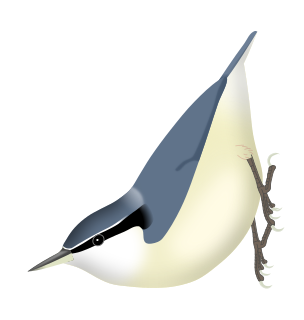 W
WThe Yunnan nuthatch is a species of nuthatch endemic to South-Western China. It was first described by William Robert Ogilvie-Grant in 1900 based on a male holotype, and it occurs in pine forests at altitudes of up to 4,000 m (13,000 ft). It is a small nuthatch, measuring 12 cm in length, without pronounced sexual dimorphism. The upperparts are gray-blue, contrasting with the light, smooth, buffy lowerparts. It has a fine white eyebrow, distinct when the plumage is fresh, and surmounting a pronounced black eye line. It is a noisy bird, producing simple, nasal sounds, sometimes in repetitive series.